中文词条参见链接(无法从中国内地访问):点击这里访问。
英文词条原文链接(无法从中国内地访问):点击这里访问。
本文基于英文词条的线索,并补充部分来自中文词条的内容。辽观搬运时进行了必要的合规化处理,以使其能够在中国内地上传。维基百科(Wikipedia)是美国维基媒体基金会的互联网百科项目,其内容可能受到立场、信息来源等因素影响,请客观看待。正文内容不代表译者观点。
辽观提供的翻译仅供参考。文中可能包含无法从中国内地访问的链接。
辽观所搬运的词条与原维基百科词条同样遵循CC-BY-SA 4.0协议,在符合协议要求的情况下您可以免费使用其内容(包括商用)。文中图片可能遵循不同的共享协议,详见辽观:“辽观百科搬运计划”涉及到的共享协议汇总
目录
0. 概述
【辽观注】此标题是我们在搬运、整合过程中添加的。
0.1 概况表格
【辽观注】此标题是我们在搬运、整合过程中添加的。
呼和浩特市(蒙古语:ᠬᠥᠬᠡᠬᠣᠲᠠ,汉语拼音字母:Hohhôt,鲍培转写:Kökeqota,西里尔字母:Хөх хот,意为“青色的城”)[注 1],通称呼市,旧称归绥,别称青城、召城[注 2],是中华人民共和国内蒙古自治区的首府,位于内蒙古中南部。市境西南接鄂尔多斯市,西北邻包头市,东北界乌兰察布市,东南达山西省忻州市、朔州市。地处蒙古高原南缘,阴山山脉南麓,北部为大青山,东南为蛮汉山,西南为土默川平原。黄河流经西南边界,大黑河从东北流向西南穿过城区并注入黄河。全市汉族人口约占87%,蒙古族人口约占10%。市政府驻新城区新华东街1号。呼和浩特主城区是由归化、绥远两座城在清末民初合并而成,故旧称“归绥”。呼和浩特处于农牧文化交界地带,自古即处于中原王朝与渗透王朝、征服王朝的交替控制中,故文化交融性较强,除汉文化外,蒙古族文化、新疆(西域)的伊斯兰文化、西藏藏传佛教文化亦对其有较重影响。
【注1(中文词条原注)】旧译名库库和屯(近代西土默特方言:Kök Hôtôn,Hôtôn在近古时期西土默特的元音和谐规律是否作hôtûn已不可考)、厚和(蒙疆政府时期译名)等。
【注2(中文词条原注)】“召”为藏语寺庙之意。因古时该地藏传佛教的寺庙众多,故也被叫成召城。明清时期一些汉文史书也音译为“赵城”。[2]
Hohhot,[a] formerly known as Kweisui,[b] is the capital of Inner Mongolia in the north of the People’s Republic of China,[5][6] serving as the region’s administrative, economic and cultural center.[7] Its population was 3,446,100 inhabitants as of the 2020 census, of whom 2,944,889 lived in the metropolitan area consisting of 4 urban districts (including Hohhot Economic and Development Zone) plus the Tümed Left Banner.[8]
【参考译文】呼和浩特[a],旧称归绥[b],是中华人民共和国北部内蒙古的首府,[5][6]是该地区的行政、经济和文化中心。[7] 截至 2020 年人口普查,其人口为 3,446,100 人,其中 2,944,889 人居住在由 4 个市区(包括呼和浩特经济开发区)和土默特左旗组成的大都市区。[8]
【注a(英文词条原注)】/hoʊˈhɒt/;[4] Mongolian: Classical: ᠬᠥᠬᠡᠬᠣᠲᠠ, Cyrillic: Хөх хот, Latin: Höh hot, Mongolian pronunciation: [ˈxɵx‿χɔʰt]; Chinese: 呼和浩特; pinyin: Hūhéhàotè; abbreviated 呼市; Hūshì
【参考译文】/hoʊˈhɒt/;[4] 蒙古语:古典:ᠬᠥᠬᠡᠬᠣᠲᠠ,西里尔字母:Хөх хот,拉丁语:Höh hot,蒙古语发音:[ˈxɵx‿χɔʰt];中文:呼和浩特;拼音: Hūhéhàotè; 简称 呼市; Hūshì
【注b(英文词条原注)】traditional Chinese: 歸綏; simplified Chinese: 归绥; pinyin: PRC Standard Mandarin: Guīsuí, ROC Standard Mandarin: Guīsuī
【参考译文】繁体中文:歸綏;简体中文:归绥;拼音:PRC标准普通话:Guīsuí,ROC标准普通话:Guīsuī
The name of the city in Mongolian means “Blue City”, although it is also wrongly referred to as the “Green City.”[9] The color blue in Mongol culture is associated with the sky, eternity and purity. In Chinese, the name can be translated as Qīng Chéng (Chinese: 青城; lit. ‘Blue/Green City’)[10] The name has also been variously romanized as Kokotan, Kokutan, Kuku-hoton, Huhohaot’e, Huhehot, Huhhot, Huhot, or Köke qota.[6]
【参考译文】这座城市的蒙古语名称意为“蓝色之城”,但也被错误地称为“绿色之城”。[9] 在蒙古文化中,蓝色与天空、永恒和纯洁有关。在中文中,该名称可以翻译为“青城”[10]。该名称也被罗马化为 Kokotan、Kokutan、Kuku-hoton、Huhohaot’e、Huhehot、Huhhot、Huhot 或 Köke qota。[6]
The city is a seat of the Inner Mongolia University, the largest regional comprehensive university and the only 211 Project University in Inner Mongolia.
【参考译文】内蒙古大学是内蒙古规模最大的地方性综合性大学、内蒙古唯一的“211工程”高校。
0.2 概况表格
【辽观注】此标题是我们在搬运、整合过程中添加的。
Coordinates (Gongzhufu Park (公主府公园))【经纬度坐标】:  40°50′05″N 111°39′23″E 40°50′05″N 111°39′23″E | |
| Country【国家】 | China【中国】 |
|---|---|
| Region【地区(一级行政区)】 | Inner Mongolia【内蒙古】 |
| County-level divisions【县域区划数】 | 10 |
| Township divisions【乡镇区划数】 | 116 |
| Established【建立于】 | 1580 |
| Municipal seat【市政府位于】 | Xincheng District【新城区】 |
| Government【政府】 | |
| • Type【类型】 | Prefecture-level city【地级市】 |
| • Body【实体】 | Hohhot Municipal People’s Congress 【呼和浩特市人民代表大会】 |
| • CCP Secretary 【中国共产党党委书记】 | Bao Gang【包钢(蒙古族)】 |
| • Congress Chairman 【人大常委会主任】 | 李炯 |
| • Mayor【政府市长】 | He Haidong【贺海东】 |
| • CPPCC Chairman【政协主席】 | 崔振武 |
| Area【面积】 | |
| • Prefecture-level city【地级市】 | 17,186.1 km2 (6,635.6 sq mi) |
| • Urban[1]【城区】 | 2,065.1 km2 (797.3 sq mi) |
| • Metro【都市区】 | 4,830.1 km2 (1,864.9 sq mi) |
| Elevation【海拔高度】 | 1,065 m (3,494 ft) |
| Population (2020 census)[2]【人口(2020年普查结果)】 | |
| • Prefecture-level city【地级市】 | 3,446,100 |
| • Density【人口密度】 | 200/km2 (520/sq mi) |
| • Urban【城区】 | 2,681,758 |
| • Urban density【人口密度】 | 1,300/km2 (3,400/sq mi) |
| • Metro【都市区】 | 2,944,889 |
| • Metro density【人口密度】 | 610/km2 (1,600/sq mi) |
| • Major ethnic groups【主要民族】 | Han【汉族】 – 87.16% Mongol【蒙古族】 – 9.98% Hui【回族】 – 1.45% |
| GDP【国内生产总值(2022年数据)】 | |
| • Prefecture-level city【地级市】 | ¥3,329.10亿(全区第3位,占全内蒙古自治区15.03%) 496.2亿美元(汇率) |
| • Per capita【人均】 | ¥101,492(全区第4位) 16,295美元(汇率) |
| Time zone【时区】 | UTC+08:00 (China Standard) 【东八区(中国标准时间)】 |
| Postal code【邮政编码】 | 010000 |
| Area code【地区代码】 | 471 |
| ISO 3166 code【国际标准代码】 | CN-NM-01 |
| License plate prefixes【车牌号标识】 | 蒙A |
| Local Dialect【本地方言】 | Jin: Zhangjiakou-Hohhot dialect;【汉语晋语张呼片】 Southern Mongolian【南部蒙语】 |
| Administrative division code 【行政区划代码】 | 150100 |
| Website【网站】 | www.huhhot.gov.cn |
1. 历史 | History
1.1 词源
呼和浩特蒙古语意为“青城”,其中“呼和”(蒙古语:ᠬᠥᠬᠡ,鲍培转写:köke)为蓝色[注 3]的意思,“浩特”(蒙古语:ᠬᠣᠲᠠ,鲍培转写:qota)为聚落、城市、城郭的意思。因中心城区北依大青山,故得名。呼和浩特这个名称最早出现在蒙古文的《俺答汗传》中,书中记载:“大名扬天下的圣主俺答汗,在水公猴年(即公元1572年,明隆庆六年),召集举世无双的巧工名匠,模仿已失去的大都(今北京),在哈剌兀那[注 4]之阳、哈屯河[注 5]之滨,始建有八座楼和琉璃金银殿的雄壮美丽的呼和浩特。”《俺答汗传》中的呼和浩特之称,是迄今为止所见最早的记载。[注 6]
【注3(中文词条原注)】区别于但偶可涵盖青色(蒙古语:ᠨᠣᠮᠢᠨ,鲍培转写:nomin)、天空蓝(蒙古语:ᠴᠡᠩᠬᠡᠷ,鲍培转写:čenker)和绿色。
【注4(中文词条原注)】“哈剌兀那”(蒙古语:ᠬᠠᠷᠠ ᠠᠭᠤᠯᠠ,鲍培转写:qar’a aɣula),意为黑山,明清著作中又称作“哈朗兀”、“喀朗乌”、“漠喀喇”等,即今呼市以北的大青山。
【注5(中文词条原注)】“哈屯河”:一说即黄河,黄河也被称为“哈屯高勒”(蒙古语:ᠬᠠᠲᠤᠨ ᠭᠣᠤᠯ,鲍培转写:qatun γool);另一说为呼市西北乌素图谷汇流而下的五里沙河,即《绥远通志稿》中之“札达海河”。
【注6(中文词条原注)】“呼和”这一蒙古语音译接近科尔沁及巴尔虎方言发音(Huh),察哈尔音发作“厚和”(Hoh),当地归化城土默特发音读作“库库”(Kök)。“浩特”在东部蒙古语中没有“条件‘ ᠨ’”,在任何变格中都不会读成“和屯”。然而,在内蒙古西部蒙语方言中却无条件带“ᠨ”读作“和屯”。“和屯”(蒙古语:ᠬᠣᠲᠠᠨ)在内蒙古东部蒙语方言中是淘河之意(也与蒙古语形容穆斯林的“浩腾”一词同音),“浩特”(卫拉特蒙古语:ᡍᡆᡐᡆ)在西部卫拉特蒙古语中是“胃”(蒙古语:ᠬᠣᠳᠣᠭᠣᠳᠣ)、“饭食”(蒙古语:ᠬᠣᠭᠣᠯᠠ)之意,故不可混用或读错。由于西土默特方言早已消亡,今日呼和浩特的蒙古语人口来自内蒙古各地,而以东部方言居多,呼和浩特一词在英译时极少写作“Kuku-hoton”(Kököhoton),而常常写作“Huhhot”和“Huhehot”,尽管按照中国国家标准罗马化时应当按照标准音译作“Hohhot”。[3]
1.2 早年历史 | Early history
呼和浩特阴山一带远古人类活动,有悠久历史。1973年在呼和浩特东北发现的距今50万年前的“大窑文化”发生于与北京周口店北京人同一时期的旧石器时代初期至晚期。
Yunzhong Commandery (Chinese: 雲中郡) was a historical commandery of China. Its territories were between the Great Wall and Yin Mountains, and correspond to part of modern-day Hohhot, Baotou and Ulanqab prefectures in Inner Mongolia. The central city of Yunzhong was in the suburbs of today’s Hohhot.
【参考译文】云中郡是中国历史上的一个郡县,其领土位于长城与阴山之间,相当于现在内蒙古呼和浩特市、包头市和乌兰察布市的部分地区。云中郡的中心城市位于今天呼和浩特市的郊区。
春秋战国之前,一些北方游牧民族,如匈奴、林胡、楼烦在今天的呼和浩特地区游牧生活。战国时代的赵国国君赵武灵王推广“胡服骑射”,打败林胡、楼烦这两个游牧民族之后,在呼和浩特托克托县建云中城。中原华夏民族开始在呼和浩特定居。“赵长城”经过呼和浩特北面的大青山。
The commandery was created during King Wuling of Zhao‘s reign after a successful campaign against the Linhu (林胡) and Loufan (樓煩) peoples.[11] After the establishment of Qin and Han dynasty, the commandery became the frontier between Han and the Xiongnu. In early Han dynasty, the region saw frequent Xiongnu raids. However, from Emperor Wu‘s reign onwards, it became an important base of military operations in the wars against the Xiongnu.[12] In 127 BC, it was from Yunzhong that General Wei Qing led a 40,000-men strong cavalry force and conquered the modern Hetao and Ordos regions. In 2 AD, the commandery administered 11 counties, namely Yunzhong (雲中), Xianyang (咸陽), Taolin (陶林), Zhenling (楨陵), Duhe (犢和), Shaling (沙陵), Yuanyang (原陽), Shanan (沙南), Beiyu (北輿), Wuquan (武泉) and Yangshou (陽壽). The population totaled 38,303 households, or 173,270 people.[13] During Eastern Han, 3 counties were abolished, while 3 new counties were added from Dingxiang Commandery. In 140 AD, the population was 5,351 households, or a population of 26,430.[14] Toward the late Han dynasty, the area’s population decreased sharply as residents fled from invading northern nomadic peoples, and the commandery was dissolved.[15]
【参考译文】赵武灵王年间,在成功击败林胡、楼烦后,云中郡成立。[11] 秦汉建立后,云中郡成为汉匈边界。汉初,该地区经常遭到匈奴的侵扰。然而,从汉武帝时期开始,这里成为抗匈战争中重要的军事基地。[12] 公元前 127 年,将军卫青率领 4 万骑兵从云中攻下了今河套和鄂尔多斯地区。公元二年,定襄郡辖云中、咸阳、陶林、楨陵、犢和、沙陵、原阳、沙南、北舆、武泉、阳寿11县,总人口38303户,173270人。[13]东汉时,撤销3县,从定襄郡增设3县。公元140年,定襄郡总人口5351户,26430人。[14]汉末,随着北方游牧民族的入侵,该地区人口急剧减少,定襄郡也随之撤销。[15]
The Tuoba chieftain Gui (called Tuoba Gui) was able to refound the Dai empire in 386. From his capital at Shengle (near modern Helingeer). His descendants would, step by step, conquer the north of China, divide the Later Yan realm into two parts, and subdue the Xia (407–431), the Later Qin (384–417) and the many Liang and Yan empires.[16]
【参考译文】拓跋珪(拓跋圭)于 386 年重建代帝国。他的都城设在盛乐(靠近现代的和林格尔)。他的后代一步步征服了中国北方,将后燕一分为二,并征服了夏朝(407-431 年)、后秦(384-417 年)以及众多的梁朝和燕朝。[16]
北魏早期都城“盛乐”即在今呼和浩特南面40千米的和林格尔县上土城村北,盛乐经济园区西。唐朝贞观年间,唐军大败突厥于白道(今呼和浩特市北蜈蚣坝)。708年(景龙二年),唐王朝在河套地区设立了东、中、西3个“受降城”。辽代的“丰州”也在这里,公元10世纪初,辽国在此设天德军及丰州。丰州故址在今呼和浩特东南约20千米的白塔村附近。公元12世纪初,女真灭辽建金,仍称丰州,是当时的军事重镇,也是人口密集,商业繁荣的州邑之一。元朝时丰州的经济文化发展迅速。文人刘秉忠诗曰:“晴空高显寺中塔,晓日平明城上楼。车马喧阗尘不到,吟鞭斜袅过丰州”。
1.3 明清时期 | Ming and Qing era
元朝被明朝推翻之后,蒙古人退居塞外,建立北元政权。明朝在漠南地区先后设置了卫所40多处,分别为十三大塞王辖区,当时呼和浩特属晋王辖区,为东胜卫所在地。1388年北元分裂为东部鞑靼和西部瓦剌。15世纪末,东部蒙古首领达延汗统一漠南蒙古实现“中兴”。1572年,蒙古首领达延汗的孙子阿勒坦汗率土默特部驻牧呼和浩特,并在今玉泉区境内建“库库和屯”城,从此土默特部从草原游牧过渡到定居生活。阿勒坦汗在此前和明朝订立的藩属关系,阿勒坦汗被封为“顺义王”。明政府于万历年间赐库库和屯汉名“归化”,意思是令少数民族归顺、化一,服从明朝廷的统治。此即归化城(即旧城)。
In 1557, the Tümed Mongol leader Altan Khan began building the Da Zhao Temple on the Tümed plain in order to convince the Ming dynasty (1368–1644) government of his leadership of the southern Mongol tribes.[17] The town that grew up around this temple was called the “Blue Town” (Kokegota in Mongolian). The Ming had been blockading the Mongols’ access to Chinese iron, cotton, and crop seeds, in order to dissuade them from attacking the North China plain. In 1570, Altan Khan successfully negotiated the end of the blockade by establishing a vassal-tributary relationship with the Ming, who changed Kokegota’s name to Guihua (traditional Chinese: 歸化; simplified Chinese: 归化; pinyin: Guīhuà; postal: Kweihua; lit. ‘Return to Civilization’) in 1575. The population of Guihua grew to over 150,000 in the early 1630s as local Mongol princes encouraged the settlement of Han Chinese merchants. There were occasional attacks on Guihua by Mongol armies, such as the total razing of the city by Ligdan Khan in 1631. Altan Khan and his successors constructed temples and fortresses in 1579, 1602 and 1727. The Tümed Mongols of the area had long since adopted a semiagricultural way of life. Hui merchants gathered north of the gate of the city’s fortress, building a mosque in 1693.[18] Their descendants formed the nucleus of the modern Huimin district.
【参考译文】1557 年,土默特蒙古领袖阿勒坦汗(俺答汗)开始在土默特平原建造大召寺,以说服明朝 (1368-1644) 政府相信他是南方蒙古部落的领袖。[17] 围绕这座寺庙发展起来的城镇被称为“蓝镇”(蒙古语为 Kokegota)。明朝一直封锁蒙古人获取中国铁、棉花和农作物种子的渠道,以阻止他们进攻华北平原。 1570 年,阿勒坦汗与明朝建立了藩属关系,成功结束了封锁。1575 年,明朝将阔克果塔改名为归化(繁体中文:歸化,简体中文:归化,拼音:Guīhuà,邮政:Kweihua,字面意思是“回归文明”)。17 世纪 30 年代初,由于当地蒙古王子鼓励汉族商人定居,归化人口增长到 15 万以上。蒙古军队偶尔会袭击归化,例如 1631 年里格丹汗将这座城市夷为平地。阿勒坦汗和他的继任者在 1579 年、1602 年和 1727 年修建了寺庙和堡垒。该地区的土默特蒙古人早已采取了半农业生活方式。回民商人聚集在城门以北,并于1693年修建了一座清真寺。[18]他们的后代构成了现代回民区的核心。
After the Manchus founded the Qing dynasty (1644–1912), the Kangxi Emperor (reigned 1661–1722) sent troops to control the region,[9] which was of interest to the Qing as a center of study of Tibetan Buddhism. Just 2 km northeast of Guihua the Qing built the strong garrison town of Suiyuan (traditional Chinese: 綏遠; simplified Chinese: 绥远; pinyin: PRC Standard Mandarin: Suíyuǎn, ROC Standard Mandarin: Suīyuǎn), from which they supervised the defense of southwestern Inner Mongolia against Mongol attacks from the north in 1735–39.[19]: 13 [20] Guihua and Suiyuan was merged into Shanxi province and became Guihua County (歸化縣; 归化县; Guīhuà Xiàn) of Qing China. French missionaries established a Catholic church in Guihua in 1874, but the Christians were forced to flee to Beijing during the antiforeign Boxer Rebellion of 1899–1901.
【参考译文】满族建立清朝(1644-1912 年)后,康熙皇帝(1661-1722 年在位)派军队控制该地区[9],清朝对该地区作为藏传佛教研究中心很感兴趣。清朝在归化东北仅 2 公里处修建了坚固的驻军城镇绥远(繁体中文:綏远;简体中文:绥远;拼音:中华人民共和国标准普通话:Suíyuǎn,中华民国标准普通话:Suīyuǎn),并在 1735-39 年间从这里监督内蒙古西南部抵御蒙古人从北方进攻的防御。[19]: 13 [20] 归化和绥远合并到山西省,成为清朝中国的归化县。 1874 年,法国传教士在归化建立了天主教堂,但在 1899 年至 1901 年的义和团运动期间,基督徒被迫逃往北京。
清朝雍正十三年(1735年)至乾隆四年又在归化城东部新建军事驻防城,命名为“绥远城”(即新城),后将“归化”、“绥远”两城合并为归化县。
1.4 民国时期 | Republican era
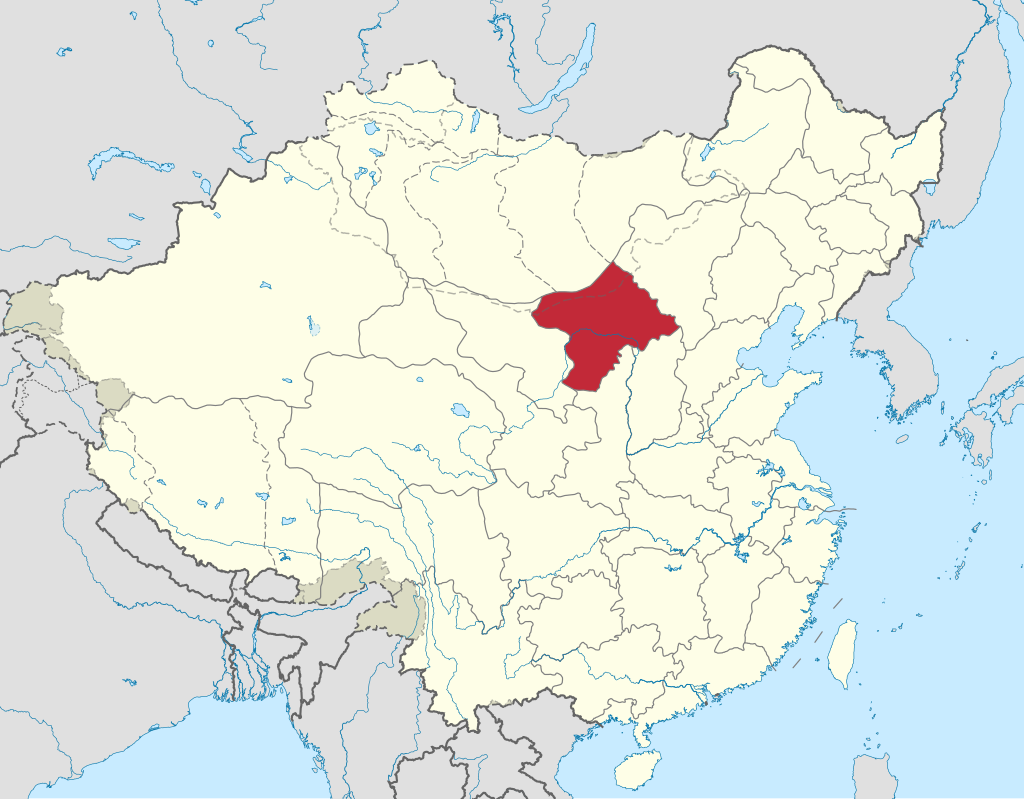
图片题注:中華民國綏遠省在中華民國的位置
参考译文:Lilauid
1913年,中华民国将之改名为归绥县,1928年,绥远省成立,以归绥县城区设立归绥市,作为省会。抗日战争时期,日本蒙疆政权将归绥市改为“厚和特别市”。日本战败后,复称归绥市。
In 1913, the government of the new Republic of China united the garrison town of Suiyuan and the old town of Guihua as Guisui (traditional Chinese: 歸綏; simplified Chinese: 归绥; pinyin: PRC Standard Mandarin: Guīsuí, ROC Standard Mandarin: Guīsuī; postal: Kweisui). Guisui town was the center of Guisui County (歸綏縣; 归绥县; PRC: Guīsuí Xiàn, ROC: Guīsuī Xiàn) and the capital of Suiyuan Province in northern China. A bubonic plague outbreak in 1917 and the connection of Guisui to railway links in Shanxi, Shaanxi, Hebei, and Beijing helped renew the economy of Guisui town by forming links with eastern China and western China’s Xinjiang province.[19]: 15 In 1918, the American specialist on Inner Asia Owen Lattimore noted Guisui’s ethnic composition as “a town purely Han Chinese except for the Lama monasteries … the Tümeds are now practically nonexistent and the nearest Mongolians are to be sought at 50 or 60 miles [80 or 100 kilometres] distance on the plateau.”[19]: 15 During the progressive Japanese invasion of China in the 1930s, the Japanese created the puppet state of Mengjiang headed by Prince De, who renamed Guisui “Blue City” (Hohhot; (Chinese: 厚和市; pinyin: Hòuhé shì).[21] After the surrender of Japan in 1945, the Republic of China changed the name back to Guisui.[19]: 16 The Communist Party of China‘s forces drove out General Fu Zuoyi, the Republic’s commander in Suiyuan, during the Chinese Civil War, and after the Chinese Revolution in 1949, Guisui was renamed Hohhot.[19]: 16
【参考译文】1913年,中华民国政府将绥远卫戍镇与归化老镇合并,定名为归绥(繁体中文:歸綏,简体中文:归绥;拼音:中华人民共和国标准官话:Guīsuí,中华民国标准官话:Guīsuī;邮政:Kweisui)。归绥镇为归绥县(歸綏县;中华人民共和国:Guīsuí Xiàn;中华民国:Guīsuī Xiàn)县治所在地,为中国北方绥远省省会。 1917 年鼠疫爆发,归绥与山西、陕西、河北和北京的铁路相通,使归绥镇与中国东部和西部的新疆省建立了联系,经济得以重振。[19]: 15 1918 年,美国内亚问题专家欧文·拉蒂莫尔 (Owen Lattimore) 指出,归绥的民族构成是“除喇嘛寺院外,其余均为汉族城镇……土默特人现在几乎已不复存在,最近的蒙古人也要在高原上五六十英里 [80 或 100 公里] 以外的地方才能找到。”[19]: 15 20 世纪 30 年代日本逐步侵华期间,日本人建立了傀儡政府蒙疆,以厚和王为首,将归绥改名为“蓝城”(呼和浩特;中文:厚和市;拼音:Hòuhé 1945 年日本投降后,中华民国改回归绥。[19]: 16 中国共产党在国共内战期间赶走了国民党驻绥远司令傅作义将军,1949 年中国革命胜利后,归绥改名为呼和浩特。[19]: 16
1.5 人民共和国时期 | People’s Republic era
During the Civil War, seeking the support of separatist Mongols, the Communists established the Inner Mongolia Autonomous Region in Mongol-minority areas of the Republic’s provinces of Suiyuan, Xing’an, Chahar, and Rehe. Guisui was chosen as the region’s administrative centre in 1952, replacing Zhangjiakou. In 1954, after the establishment of the People’s Republic of China, the city was renamed from Guisui to Hohhot, though with a different Chinese pronunciation of Huhehaote.[19]: 16
【参考译文】内战期间,为寻求分离主义蒙古人的支持,共产党在内蒙古自治区绥远、兴安、察哈尔和热河等省的蒙古族聚居区成立了内蒙古自治区。1952 年,归绥取代张家口成为自治区的行政中心。1954 年,中华人民共和国成立后,该市由归绥改名为呼和浩特,但汉语发音“呼和浩特”与蒙语发音不同。[19]: 16
The city has seen significant development since China’s reform and opening began. The city’s far east side began development around 2000 and is now home to the municipal government, most of the Autonomous Region’s administrative buildings,[22] an artificial lake called Ruyi He,[23] and a large number of condominiums, mostly built by the local real estate company Gold Horse International Inc. The Hohhot City Stadium, built on the city’s north side, was finished in 2007.[24]
【参考译文】自中国改革开放以来,呼和浩特市经历了显著的发展。呼和浩特市的东部地区于 2000 年左右开始开发,目前是市政府、自治区大部分行政大楼、人工湖如意河和大量公寓的所在地,这些公寓大多由当地房地产公司金马国际公司建造。呼和浩特市体育场建于呼和浩特市北部,于 2007 年竣工。
A city with a rich cultural background, Hohhot is known for its historical sites and temples and is one of the major tourist destinations of Inner Mongolia. It is also nationally known as the home of China’s dairy giants Mengniu and Yili,[25][26] and was declared “Dairy Capital of China” by the China Dairy Industry Association and the Dairy Association of China in 2005.
【参考译文】呼和浩特是一座文化底蕴深厚的城市,以其历史遗迹和寺庙而闻名,是内蒙古的主要旅游目的地之一。呼和浩特也是全国闻名的中国乳业巨头蒙牛和伊利的故乡[25][26],2005 年被中国乳制品工业协会和中国奶业协会评为“中国乳业之都”。
2. 地理 | Geography
呼和浩特位于内蒙古中南部,北面是阴山山脉的大青山,西与包头市、鄂尔多斯市接壤,东邻乌兰察布市,南面是河套地区,全市总面积17224平方千米,地势由东北向西南逐渐倾斜,平均海拔1000米左右。河流有大黑河、小黑河等,1958年兴建红领巾水库,库容1650万立米,灌溉面积11万亩。
2.1 气候 | Climate
呼和浩特属于中温带半干旱气候,四季分明,季风影响显著。冬季严寒干燥,多大风。夏季温暖,相对湿润,降水量超过全年的65%。全年日照充足,年日照时数超过2860小时。年平均降水量为335.2~534.6毫米,且主要集中在7~8月。西南年均降水量仅350毫米,平原区在400毫米左右,大青山区在430~500毫米。1月平均气温-11.6℃,极端最低气温-32.8℃(1951年2月6日)。7月平均气温22.6℃,极端最高气温38.9℃(2010年7月30日)。年平均气温6.7℃。[5]
Hohhot is a popular destination for tourists during the summer months because of the nearby Zhaohe grasslands. More recently, due to desertification, the city sees sandstorms on almost an annual basis. With monthly percent possible sunshine ranging from 54 percent in November to 66 percent in September, sunshine is abundant year-round, the city receives 2,680 hours of bright sunshine annually. Extreme temperatures have ranged from −32.8 °C (−27 °F) on 6 February 1951 to 38.9 °C (102 °F) on 30 July 2010.[30]
【参考译文】呼和浩特是夏季游客的热门目的地,因为附近有昭河草原。最近,由于沙漠化,该市几乎每年都会遭遇沙尘暴。每月日照率从 11 月的 54% 到 9 月的 66% 不等,全年阳光充足,该市每年有 2,680 小时的明媚日照。极端温度范围从 1951 年 2 月 6 日的 −32.8 °C (−27 °F) 到 2010 年 7 月 30 日的 38.9 °C (102 °F)。[30]
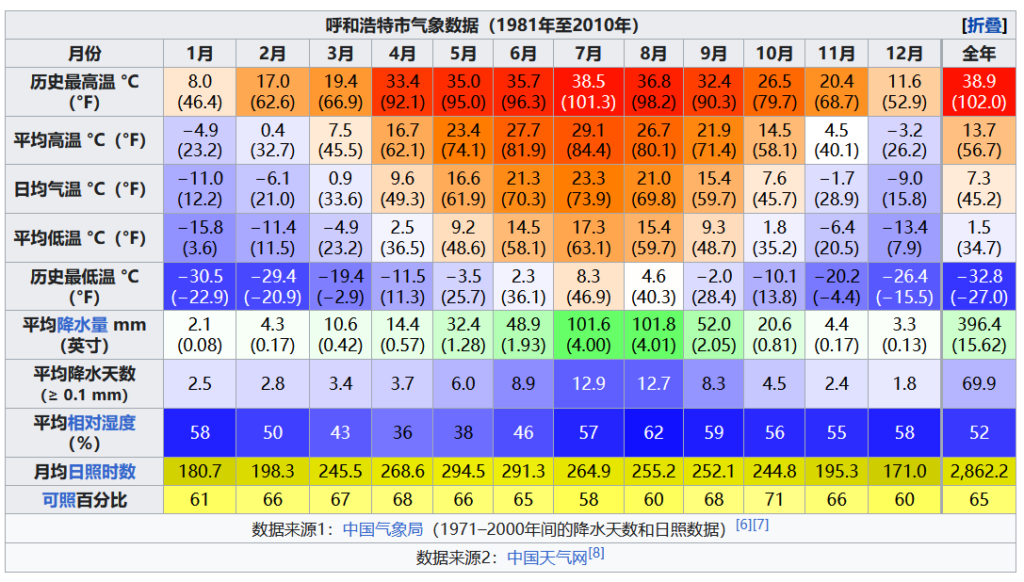
3. 政治
3.1 现任领导
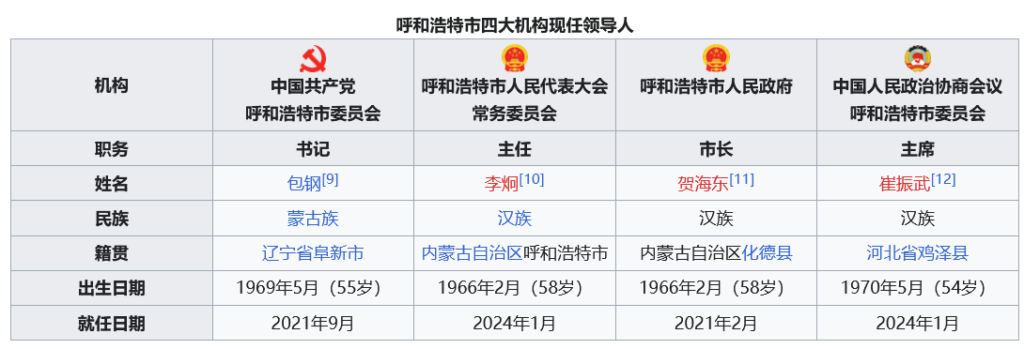
3.2 行政区划 | Administrative divisions
The city is administratively at the prefecture-level, meaning that it administers both its urban area and the rural regions in its vicinity. The administrative area includes 4 counties, 4 districts, and a county-level banner; they are further divided into 20 urban sub-districts, and 96 townships. The data here represented is in km2 and uses data from the 2010 Census.
【参考译文】该市行政级别为地级,即它管辖市区和周边农村地区。行政区域包括 4 个县、4 个区和一个县级旗;它们进一步划分为 20 个城市街道和 96 个乡镇。此处的数据以平方公里为单位,使用 2010 年人口普查数据。
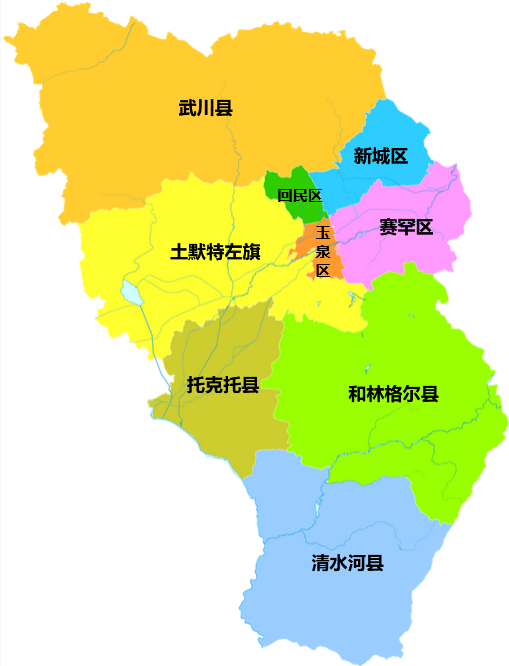
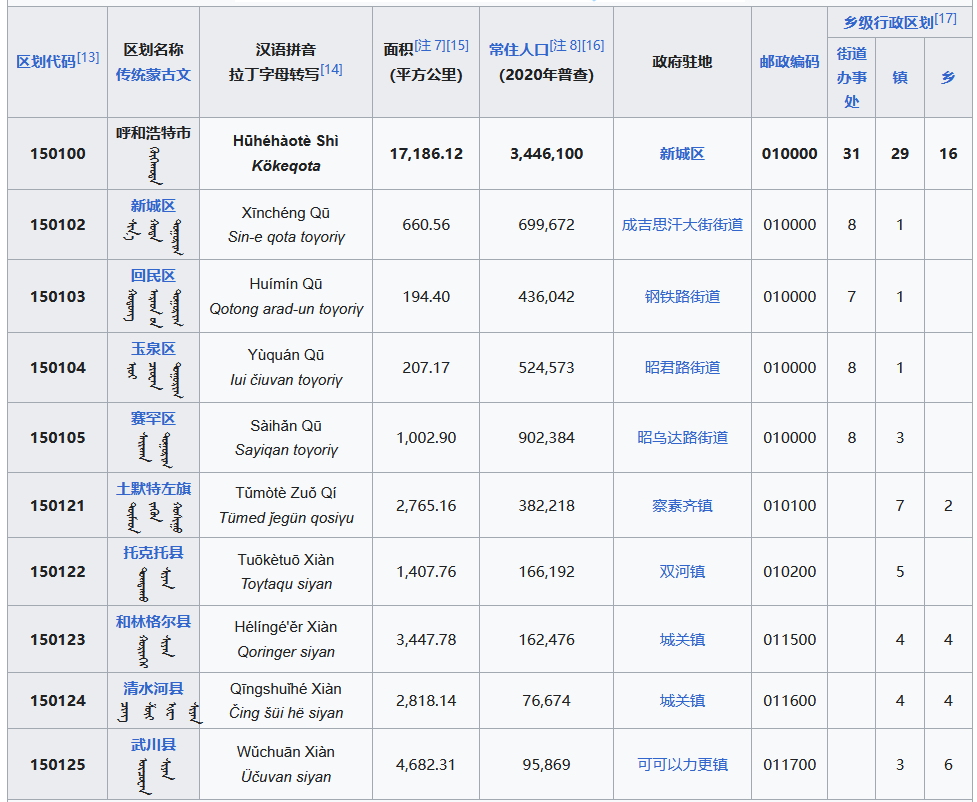
【注7(中文词条原注)】土地面积为第二次全国土地调查结果数据。
【注8(中文词条原注)】常住人口为2020年第七次全国人口普查数据。
4. 人口统计 | Demographics

根据2010年第六次全国人口普查,全市常住人口为2866615人[18],同第五次全国人口普查相比,十年共增加428717人,增长17.59%。年平均增长率为1.63%。其中,男性人口为1462277人,占51.01%;女性人口为1404338人,占48.99%。常住人口性别比(以女性为100)为104.13。0-14岁人口为398716人,占13.91%;15-64岁人口为2248977人,占78.45%;65岁及以上人口为218922人,占7.64%。
2018年末,全市有常住人口312.6万人,其中城镇人口218.3万人,城镇化率69.8%。全市户籍人口245.8万人。[19]
根据2020年第七次全国人口普查,全市常住人口为3,446,100人[20]。同第六次全国人口普查的2,866,615人相比,十年共增加了579,485人,增长20.21%,年平均增长率为1.86%。其中,男性人口为1,740,118人,占总人口的50.5%;女性人口为1,705,982人,占总人口的49.5%。总人口性别比(以女性为100)为102。0-14岁的人口为479,255人,占总人口的13.91%;15-59岁的人口为2,345,550人,占总人口的68.06%;60岁及以上的人口为621,295人,占总人口的18.03%,其中65岁及以上的人口为412,099人,占总人口的11.96%。居住在城镇的人口为2,727,517人,占总人口的79.15%;居住在乡村的人口为718,583人,占总人口的20.85%。
2022年末,全市常住人口355.11万人[21],比上年末增加5.55万人。 其中,城镇人口283.39万人,乡村人口71.72万人;常住人口城镇化率达79.80%,比上年提高0.12个百分点。 男性人口179.20万人,女性人口175.91万人。
4.1 民族
全市居住着蒙、汉、回、满、朝鲜、达斡尔、鄂温克、鄂伦春等36个民族。常住人口中,汉族人口为2,943,814人,占85.42%;蒙古族人口为398,688人,占11.57%;其他少数民族人口为103,598人,占3.01%。与2010年第六次全国人口普查相比,汉族人口增加445,167人,增长17.82%,占总人口比例下降1.74个百分点;各少数民族人口增加134,318人,增长36.5%,占总人口比例增加1.74个百分点。其中,蒙古族人口增加112,719人,增长39.42%,占总人口比例增加1.59个百分点;回族人口增加3,217人,增长7.77%,占总人口比例下降0.15个百分点;满族人口增加11,246人,增长36.71%,占总人口比例增加0.15个百分点。
The majority of the population of Hohhot are Han Chinese, representing 87.16 percent of the total population in 2010. Most Han in Hohhot, if their ancestry is traced several decades back, have ancestors from Shanxi, northeast China, or Hebei. Most Mongols in the city speak Chinese. A 1993 survey conducted by Inner Mongolia University found that only 8 percent of Tümed Mongols (the majority tribe in Hohhot) could speak the Mongolian language.[19]: 15 A significant portion of the population is of mixed ethnic origin. According to the anthropologist William Jankowiak, author of the book Sex, Death, and Hierarchy in a Chinese City (1993), there is “relatively little difference between minority culture and Han culture” in Hohhot, with differences concentrating around relatively minor attributes such as food and art, and similarities abounding over fundamental issues of ethics, status, life goals, and worldview.[19]: 5
【参考译文】呼和浩特市的大多数人口是汉族,2010 年占总人口的 87.16%。如果追溯到几十年前,呼和浩特市的大多数汉族人的祖先都是山西、东北或河北。该市的大多数蒙古人讲汉语。内蒙古大学 1993 年的一项调查发现,只有 8% 的土默特蒙古人(呼和浩特市的主要部落)会说蒙古语。[19]: 15 相当一部分人口是混血儿。根据《中国城市的性、死亡和等级》(1993 年)一书的作者人类学家威廉·扬科维亚克的说法,呼和浩特市的“少数民族文化和汉族文化之间的差异相对较小”,差异集中在食物和艺术等相对次要的属性上,而在道德、地位、人生目标和世界观等基本问题上则有很多相似之处。[19]: 5

5. 经济 | Economy
Hohhot is a major industrial center within Inner Mongolia. Together with Baotou and Ordos, it accounts for more than 60 percent of the total industrial output of Inner Mongolia.[37] After Baotou and Ordos, it is the third-largest economy of the province, with GDP of RMB 247.56 billion in 2012, up 11.0 percent year on year.[38] Hohhot accounted for approximately 15.5 percent of the province’s total GDP in 2012.[39] It is also the largest consumer center in the region, recording ¥102.2 billion retail sales of consumer goods in 2012, an increase of 14.9 percent from 2011.[38] The city has been a central developmental target for the China Western Development project being pursued by the Central Government. There are many famous enterprises located in Hohhot, including China’s largest dairy producer by sales revenue, the Inner Mongolia Yili Industrial Group, and the China Mengniu Dairy Co.[40]
【参考译文】呼和浩特是内蒙古的主要工业中心。它与包头和鄂尔多斯合计占内蒙古工业总产值的 60% 以上。[37] 继包头和鄂尔多斯之后,它是内蒙古第三大经济体,2012 年 GDP 为 2475.6 亿元人民币,同比增长 11.0%。[38] 2012 年,呼和浩特约占全省 GDP 总量的 15.5%。[39] 它也是该地区最大的消费中心,2012 年社会消费品零售额为 1022 亿元人民币,比 2011 年增长 14.9%。[38] 该市一直是中央政府实施的西部大开发项目的重点发展目标。呼和浩特市拥有多家知名企业,包括中国销售收入最大的乳制品生产商内蒙古伊利实业集团、中国蒙牛乳业股份有限公司[40]。
2018年,呼和浩特市实现生产总值2903.5亿元,按可比价格计算,比上年增长3.9%。第一产业增加值占全市生产总值的比重为3.7%,第二产业增加值比重为27.6%,第三产业增加值比重为68.7%。其中,第一产业增加值增长2.1%,第二产业增加值增长2.4%,第三产业增加值增长4.6%。
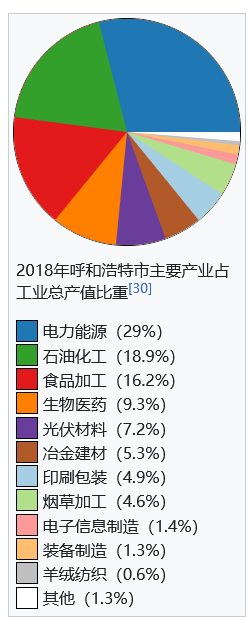
食品加工、电力能源、石油化工、生物医药、光伏材料、电子信息被称为呼和浩特的六大优势支柱产业。[31]2018年,六大产业产值总计1157.8亿元人民币,较上年增长6.3%,占呼和浩特工业总产值的82.6%。[30]
呼和浩特是中国著名的奶业基地,总部位于呼和浩特金川经济园区的伊利集团和位于呼和浩特盛乐经济园区的蒙牛集团,是当今中国奶业界的两大企业,其产品行销中国各地以及周边国家。
2005年,中国政府正式授予呼和浩特市“中国乳都”的称号。
近年来,呼和浩特市的服务业发展迅速,已经逐渐成为该市的经济支柱,其中金融服务业水平在内蒙古地区列首位。
As the economic center of Inner Mongolia, Hohhot’s urban area has expanded greatly since the 1990s. CBDs have grown rapidly in all the city’s major districts. The completion of a new office tower for the Municipal Government in Eastern Hohhot marked a shift of the city center to the east. Hailiang Plaza (海亮广场), a 41-floor tower constructed in the city center, became one of the few notable department stores for luxury merchandise in the city.
【参考译文】作为内蒙古的经济中心,呼和浩特市自上世纪九十年代以来城市规模迅速扩大,各主要城区CBD迅速崛起,随着呼和浩特市东部新市政府办公楼的落成,呼和浩特市中心的重心开始向东转移,市中心新建的41层高楼海亮广场成为呼和浩特为数不多的知名奢侈品百货商场之一。
5.1 主要的开发区 | Major development zones
- Hohhot Economic and Technological Development Zone【呼和浩特经济技术开发区】
- Hohhot Export Processing Zone【呼和浩特出口加工区】
6. 文化 | Culture
Due to its relatively diverse cultural make-up, and despite its characteristics as a mid-sized Chinese industrial city, the Hohhot street scene has no shortage of ethnic minority elements. Tongdao Road, a major street in the old town area, is decorated with Islamic and Mongol exterior designs on all its buildings. A series of government initiatives in recent years have emphasized Hohhot’s identity with ethnic minority groups, especially in increasing Mongol-themed architecture around the city. By regulation, all street signs and public transportation announcements are in both Chinese and Mongolian.[41]
【参考译文】由于文化构成相对多元,尽管呼和浩特是一座中型工业城市,但其街头场景中并不缺乏少数民族元素。通道路是老城区的主要街道,所有建筑都采用伊斯兰和蒙古风格的外墙设计。近年来,政府采取了一系列举措,强调呼和浩特的少数民族身份,特别是在城市周围增加蒙古主题建筑。根据规定,所有街道标志和公共交通公告都使用中文和蒙古语。[41]
当地文化是一种典型的游牧文化与农耕文化的结合体,再加上现代文明的影响,文化历史遗迹无一不体现北方民族特有的朴实、豪放、大气的特征。有专门的蒙古语学校、歌舞艺术表演的乌兰牧骑,还有比较有特色的民族服装表演等等,非常有特色。蒙古族典型的乐器马头琴奏出的悠扬乐曲,伴随蒙古族歌手高亢、低回的歌声,使人回味悠长。
内蒙古因为地理跨度较大,所以其各盟的农耕文化与相邻各省相互融通。如内蒙西部与西北的语言习俗等更为相近,东四盟饮食则与东三省更为接近。
6.1 方言 | Dialect
See also: Hohhot dialect【参见:“呼和浩特方言”】
Older Hohhot residents mostly tend to converse in the Hohhot dialect, a branch of the Jin language from neighbouring Shanxi province. This spoken form can be difficult to understand for speakers of other Mandarin Chinese dialects. The newer residents, mostly concentrated in Xincheng and Saihan Districts, speak Hohhot-based Mandarin, the majority also with a noticeable accent and some unique vocabulary.
【参考译文】呼和浩特的老居民大多使用呼和浩特方言交谈,这是邻近山西省晋语的一个分支。这种口语形式对于其他普通话方言使用者来说可能难以理解。新居民主要集中在新城区和赛罕区,讲以呼和浩特为基础的普通话,大多数人还带有明显的口音和一些独特的词汇。
6.2 饮食 | Cuisine
Food specialty in the area is mostly focused on Mongol cuisine and dairy products. Commercially, Hohhot is known for being the base of the nationally renowned dairy giants Yili and Mengniu. The Mongol drink suutei tsai (Chinese: 奶茶; pinyin: nǎichá; lit. ‘milk tea‘), has become a typical breakfast selection for anyone living in or visiting the city.[42] The city also has rich traditions in the making of hot pot and shaomai, a type of traditional Chinese dumpling served as dim sum.[43]
【参考译文】该地区的特色食品主要集中在蒙古菜和乳制品上。从商业角度来看,呼和浩特以全国知名乳业巨头伊利和蒙牛的基地而闻名。蒙古饮料奶茶(中文:奶茶;拼音:nǎichá;字面意思是“奶茶”)已成为居住在该市或来访该市的任何人典型的早餐选择。[42] 这座城市在火锅和烧卖制作方面也有着丰富的传统,烧麦是一种传统的中式饺子,可作为点心食用。[43]
羊背子、烤全羊、涮羊肉、手把羊肉、烤羊腿、血肠、肉肠、羊杂碎汤、烧麦、莜面、马奶酒、奶茶、奶皮子、奶豆腐、奶酪、油香、麻花、馓子、酿皮、焙子、山药丸子、红糖月饼、刀削面、饸饹(hé lao)面、剔鱼子、煮鱼、托县炖鱼、和林炖羊肉等。其饮食受蒙古族饮食、回族饮食、晋陕饮食的影响很深。
6.3 旅游
著名旅游景点:旧石器时代的大窑文化遗址、和林格尔汉墓壁画、昭君墓,辽代的白塔,明代的绥远城墙、大召、乌素图召、喇嘛洞召、席力图召,清代的五塔寺、和硕恪靖公主府、绥远将军衙署、天主教绥远教区主教座堂、清真大寺,乌兰夫故居。以及素有“塞外西湖”之称的哈素海国家公园、哈达门高原牧场、大青山野生动物园等值得游览。新建的如意和(俗称如意河)游览区呈现现代城市风貌。参见呼和浩特八景。
6.4 宗教
呼和浩特的宗教以藏传佛教为盛,旧时召庙林立,有“召城”之称,但汉传佛教毫无发展。除佛教外,因呼和浩特回族众多,故伊斯兰教在固定群体中也有所信仰。此外天主教、基督新教、道教亦有所发展。
6.5 全国重点文物保护单位
- 万部华严经塔
- 金刚座舍利宝塔
- 和硕恪靖公主府
- 王昭君墓
- 大召
- 大窑遗址
- 乌兰夫故居
- 和林格尔土城子遗址
- 绥远城墙和将军衙署
- 云中郡故城
- 和林格尔东汉壁画墓
- 乌素图召
- 席力图召及家庙
- 呼和浩特清真大寺
- 广化寺造像
- 呼和浩特天主教堂
7. 交通 | Transportation
呼和浩特交通发展较快,已形成较为完善的交通体系。
7.1 机场 | Airport
Hohhot’s Baita International Airport (IATA:HET) is located about 14.3 km (8.9 mi) east of the city centre by car. It has direct flights to larger domestic cities including Beijing, Tianjin,[44] Shanghai, Shenzhen, Chengdu, and others. It also has flights to Taichung,[45] Hong Kong, and Ulaanbaatar, Mongolia.
【参考译文】呼和浩特白塔国际机场 (IATA:HET) 位于市中心以东约 14.3 公里(8.9 英里)处。该机场有直飞北京、天津、[44] 上海、深圳、成都等国内大城市的航班。它还有飞往台中、[45] 香港和蒙古国乌兰巴托的航班。
空运交通方面,呼和浩特白塔国际机场是内蒙古第一大航空枢纽,位于市区东南15公里处,航线基本覆盖全国各大省会城市及中小城市。2018年新机场选址报备工作已经就绪,新址搬迁准备工作结束,已于2019年进场施工。新机场名为“呼和浩特盛乐国际机场”[23],新机场按照4F级标准设计,可以起降绝大多数客货运机型。新机场建设完成后预计于2030年达到年客运量2500万人次和年货运量35万吨目标。
7.2 铁路 | Railway
铁路交通方面,有呼和浩特站与呼和浩特东站两大客运站,有始发开往北京西、上海、成都、兰州、西宁、西安、杭州及昆明等的列车,还有途径列车通往天津、哈尔滨、沈阳、杭州、深圳、广州、乌鲁木齐等的列车,区内有始发开往乌海西、二连、东胜西、通辽、乌兰浩特、锡林浩特、额济纳的列车,以及开往包头、集宁南的城际动车组列车,范围覆盖全区所有盟市。呼和浩特站每周三、四有发往乌兰巴托的国际列车。2019年底,随着呼张高铁及京张高铁全线通车,草原动车最快2小时9分可抵京。京呼高铁是中国“八纵八横”高速铁路网北京至兰州通道的重要组成部分。这一高铁的全线开通,将极大便利沿线人民群众出行,畅通呼包鄂地区与京津冀地区的联系,对促进少数民族地区发展和区域经济社会协调发展,具有十分重要的意义。[24]2021年,内蒙古自治区印发呼包鄂乌“十四五”一体化发展规划,并提出共建轨道上的呼包鄂乌,统筹干线铁路、城际铁路、市域(郊)铁路、城市轨道交通四网融合发展,构建高品质快速轨道交通网,12月8日,据包头站消息,呼包鄂乌城际管内动车组列车开行铁路e卡通服务。[25][26][27]
Hohhot lies on the Jingbao Railway from Beijing to Baotou, and is served by two railway stations: Hohhot railway station and Hohhot East railway station.[46] The line began operation in 1921.[47] Trains to Beijing link to destinations to the south and the northeast. The most prominent rail link with Beijing is the overnight K90 train, which has served the Hohhot-Beijing line since the 1980s and is referred to colloquially as the “9-0”. Westbound trains go through Baotou and Lanzhou. There are also rail links to most major Inner Mongolian cities and to Ulaanbaatar, Mongolia.
【参考译文】呼和浩特位于京包铁路上,京包铁路连接北京和包头,有两个火车站:呼和浩特火车站和呼和浩特东火车站。[46] 这条铁路线于 1921 年开始运营。[47] 开往北京的列车可通往南部和东北部。与北京最主要的铁路连接是夜间 K90 列车,自 1980 年代以来一直运行在呼和浩特-北京线上,俗称“9-0”。西行列车经过包头和兰州。还有通往内蒙古大部分主要城市和蒙古乌兰巴托的铁路连接。
Because the quickest trip to Beijing takes around six and a half hours despite the relatively close proximity of the two cities, plans for high-speed rail were discussed extensively prior to the construction of a high-speed railway station beginning in 2008. The station was completed in 2011 and initially serviced only ordinary lines. In January 2015, CRH opened its first D-series (dongchezu) route in Inner Mongolia in the Baotou-Hohhot-Jining corridor, shortening travel time between Inner Mongolia’s two largest cities to a mere 50 minutes.[48] This line reached a maximum speed of 200 km/h (124 mph) between Hohhot and Baotou. Another high-speed rail line linking Hohhot to Zhangjiakou and the planned Beijing-Zhangjiakou railway are due for completion in 2017, and are designed to operate at 250 km/h (155 mph). The section between Hohhot and Ulanqab (Jining) opened in August 2017; travel time between the two cities was shortened to 40 minutes.[49]
【参考译文】尽管北京和呼和浩特两座城市距离较近,但最快到北京的行程也只需六个半小时,因此在 2008 年高铁站建设之前,人们就广泛讨论了高铁计划。高铁站于 2011 年建成,最初只服务普通线路。2015 年 1 月,动车组在内蒙古包头-呼和浩特-集宁走廊开通了第一条 D 系(动车组)路线,将内蒙古两大城市之间的旅行时间缩短至仅仅 50 分钟。[48] 这条线路在呼和浩特和包头之间最高时速达到 200 公里/小时(124 英里/小时)。另一条连接呼和浩特至张家口的高铁线路和计划中的京张铁路将于 2017 年完工,设计时速为 250 公里/小时(155 英里/小时)。 2017 年 8 月,呼和浩特至乌兰察布(集宁)段开通,两地间行车时间缩短至 40 分钟。[49]
7.3 高速公路 | Expressways
公路交通方面,最早建成的高速公路有 呼包高速公路(现纳入京藏高速公路和京新高速公路)。京藏高速将北京到呼和浩特的驾车时间缩短到5个小时。110国道、209国道过境。有开往蒙古、俄罗斯边境省区通车的6条客运班车路线。省级大通道贯穿内蒙古全境。市内已建成成网状的高架快速路,大大缓解了呼和浩特城区车辆拥堵问题。
An expressway built in 1997 (then known as the Hubao Expressway) links Hohhot with Baotou. In recent years this expressway has been expanded eastwards to Jining and Zhangjiakou, and on to Beijing as part of the G6 Beijing–Lhasa Expressway (Jingzang Expressway). The city is on the route of China National Highway 110, which runs from Yinchuan to Beijing. China National Highway 209 begins in Hohhot and carries traffic southbound towards southern China, with its terminus in Guangxi. Hohhot is connected to its northern counties by the Huwu Highway, which was completed in 2006. Previously, travel to the northern counties had required lengthy navigation through mountainous terrain.
【参考译文】1997 年修建的高速公路(当时称为呼包高速公路)连接呼和浩特和包头。近年来,这条高速公路向东延伸至集宁和张家口,并作为 G6 京拉高速公路(京藏高速公路)的一部分延伸至北京。该市位于中国国道 110 线沿线,该线从银川延伸至北京。中国国道 209 线始于呼和浩特,向南通往华南地区,终点位于广西。呼和浩特通过 2006 年建成的呼乌高速公路与北部各县相连。以前,前往北部各县需要长途跋涉穿越山区。
Long-distance buses connect Hohhot to outlying counties, the cities of Baotou, Wuhai, and Ordos, and other areas in Inner Mongolia.
【参考译文】长途汽车连接呼和浩特与边远县市、包头市、乌海市、鄂尔多斯市以及内蒙古其他地区。
7.4 公共交通和市内道路交通 | Public transport & Roadways
Hohhot’s major north–south thoroughfares are called roads (Lu) and its east–west thoroughfares are called streets (Jie). The largest elevated interchange is near the site of the city’s Drum Tower (Gulou), after which it is named. Several major streets are named after Inner Mongolian leagues and cities; among these, Hulun Buir, Jurim (now Tongliao), Ulaanhad (Now Chifeng), Xilin Gol, and Xing’an run north–south, while Bayannur, Hailar, Ulaanqab, and Erdos run east–west.
【参考译文】呼和浩特市的主要南北通道称为路,东西通道称为街。最大的高架立交桥位于该市鼓楼(古楼)附近,并因此得名。几条主要街道以内蒙古联盟和城市命名;其中,呼伦贝尔、哲里木(现通辽)、乌兰哈达(现赤峰)、锡林郭勒和兴安为南北走向,而巴彦淖尔、海拉尔、乌兰察布和鄂尔多斯为东西走向。
The city’s public transit system is composed of nearly one hundred bus routes and a large fleet of taxicabs, which are normally green or blue. Bus fare is 1 yuan; taxi fares begin at 8 yuan.
【参考译文】该市的公共交通系统由近百条公交线路和大量出租车组成,出租车通常为绿色或蓝色。公交车票价为 1 元,出租车票价为 8 元起。
市内有4000余辆出租车,昼夜服务,收费为:起步价¥8,2公里,之后每公里¥1.3,停车等候或时速低于12km/h收费每5分钟¥1.3,21:00-06:00,每车1公里加收的夜间行驶费¥0.1,行驶10公里后每公里¥1.5,每程收燃油附加费¥1。
呼和浩特地铁共规划有5条线路,目前1号线一期工程和2号线一期工程均已开通,1号线一期工程东起坝堰(机场)站,西至伊利健康谷站,全线长21.72公里,共设车站20座,2019年12月29日开通试运营。[28]2号线一期工程东北起塔利东路站,南至阿尔山路站,全线长27.3公里,共设车站24座,于2020年10月1日开通初期运营。[29]
8. 教育 | Education
Universities located in Hohhot include:
【参考译文】位于呼和浩特的大学包括:
- Inner Mongolia University of Finance and Economics / Inner Mongolia College of Finance and Economics【内蒙古财经大学(原内蒙古财经学院)】
- Inner Mongolia University, only 211 Project University in Inner Mongolia.[51]【内蒙古大学,内蒙古唯一一所211工程大学。[51]】
- Inner Mongolia University of Agriculture【内蒙古农业大学(原内蒙古农牧学院、内蒙古林学院)】
- Inner Mongolia Normal University【内蒙古师范大学(原内蒙古师范学院)】
- Inner Mongolia University of Technology【内蒙古工业大学(原内蒙古工学院)】
- Inner Mongolia College of Medicine【内蒙古医科大学(原内蒙古医学院)】
- Hohhot College of Education【呼和浩特教育学院】
- Hohhot College of Police【呼和浩特警官学院】
- Honder College of Inner Mongolia Normal University【内蒙古师范大学弘德学院】
- 呼和浩特民族学院
- 呼和浩特职业学院
- 内蒙古大学创业学院
- 内蒙古商贸职业学院
- 内蒙古化工职业学院
High Schools located in Hohhot include:
【参考译文】位于呼和浩特市的中学包括:
- Hohhot No.2 Middle School【呼和浩特市第二中学】
- Affiliated Middle School to Inner Mongolia Normal University【内蒙古师范大学附属中学】
- Hohhot experimental middle school【呼和浩特市实验中学】
- Hohhot No.1 Middle School【呼和浩特市第一中学】
9. 体育运动 | Sports
Hohhot lacked a professional soccer team until Shenyang Dongjin F.C. relocated to Hohhot, changing their name to Hohhot Dongjin, in 2012.[52] They played at Hohhot City Stadium, which was newly built in 2007.[24] The club finished in the bottom of the league in the 2012 season and was and relegated to League Two. After playing half a season at Hohhot in 2013, the team relocated to Liaoning and chose Benxi City Stadium as their new home court.[53]
【参考译文】呼和浩特一直没有一支职业足球队,直到 2012 年,沈阳东进足球俱乐部迁至呼和浩特,更名为呼和浩特东进足球俱乐部。[52] 他们在 2007 年新建的呼和浩特市体育场踢球。[24] 俱乐部在 2012 赛季排名联赛垫底,并降入乙级联赛。2013 年在呼和浩特踢了半个赛季的球后,球队迁至辽宁,并选择本溪市体育场作为新主场。[53]
On 14 January 2015, Taiyuan Zhongyou Jiayi F.C. moved to Hohhot and changed their name to Nei Mongu Zhongyou F.C.[54] The team play in China League One and chose Hohhot City Stadium as their home in 2015. The team had been first established as Shanxi Jiayi F.C. on 8 October 2011.[55]
【参考译文】2015 年 1 月 14 日,太原中优嘉益足球俱乐部迁至呼和浩特,并更名为内蒙古中优足球俱乐部。[54] 该队参加中国足球甲级联赛,2015 年选择呼和浩特市体育场作为主场。该队最初于 2011 年 10 月 8 日成立,名称为山西嘉益足球俱乐部。[55]
10. 知名地标 | Notable landmarks
There were over 50 Ming and Qing Buddhist temples and towers in Guihua and Suiyuan.
- Zhaojun Tomb (昭君墓), located about nine kilometers south of the city center. It is said to be the tomb of Wang Zhaojun, a woman of the Han Empire who married a Xiongnu Chanyu (king).
【参考译文】昭君墓,位于市中心以南约九公里处。据说是汉朝女子王昭君的墓,她后来嫁给了匈奴单于。 - Baita Pagoda (白塔), located in the eastern rural area nearing the airport. It was constructed during the Liao Dynasty. The airport of Hohhot is named after Baita Pagoda.
【参考译文】白塔,位于机场附近的东部农村地区。它建于辽代。呼和浩特机场因白塔而得名。 - Da Zhao Temple (大召), located in the centre of Guihua town. It was constructed in the Northern Yuan Dynasty and is the oldest Buddhist lama monastery in the city.[56]
【参考译文】大召寺,位于归化镇中心。建于北元,是该市最古老的佛教喇嘛寺院[56]。 - Temple of the Five Pagodas (五塔寺), located in the eastern part of Guihua town. It was completed in the Qing Dynasty, with architecture very similar to that of Indian temples.[42] On its walls there are more than 1,500 figures of Buddha.
【参考译文】五塔寺,位于归化镇东部。五塔寺建于清代,建筑风格与印度寺庙十分相似。[42] 五塔寺墙上有 1500 多尊佛像。 - Residence of Gurun Princess Kejing (固倫恪靖公主府), located at the foot of Yinshan Mountain. It was the mansion of Gurun Princess Kejing of the Qing Dynasty, who was married to a Mongol prince.
【参考译文】固伦恪靖公主府,位于阴山脚下,为清朝固伦恪靖公主嫁给蒙古王子的府邸。 - Residence of the General (將軍衙署), located in the centre of Suiyuan town. It was the residence and office building of Suiyuan Generals of the Qing Dynasty.
【参考译文】将军衙署,位于绥远市中心,为清代绥远将军的府邸和办公场所。 - Great Mosque of Hohhot (清真大寺), located out of the northern gate of Guihua town. It was constructed during the Qing Dynasty.
【参考译文】清真大寺,位于呼和浩特市归化镇北门外,为清代所建。 - Inner Mongolia Museum (内蒙古博物院). Main exhibits include dinosaur fossils, historical artifacts of nomadic peoples, and the cultural life of modern nomadic peoples.
【参考译文】内蒙古博物院。主要展品有恐龙化石、游牧民族历史文物、现代游牧民族文化生活等。 - Qingcheng Park (青城公园), formerly People’s Park, in the city center[57]
【参考译文】青城公园,原为人民公园,位于市中心[57]

图片题注:Great Mosque of Hohhot【呼和浩特清真大寺】
图片作者:Satbir Singh from London
11. 友好城市
A. 参见(维基百科的相关词条)| See also
![]() China portal【中国主题】
China portal【中国主题】
- Manhan folk song【漫瀚调】
- Suiyuan Province【绥远省】
B. 参考文献 | References
B.1 英文词条引用列表(标号与文中对应)
- ^ Ministry of Housing and Urban-Rural Development, ed. (2019). China Urban Construction Statistical Yearbook 2017. Beijing: China Statistics Press. p. 48. Archived from the original on 18 June 2019. Retrieved 11 January 2020.
- ^ “Nèi Mĕnggŭ / Inner Mongolia (China): Prefectural Division & Major Cities – Population Statistics, Maps, Charts, Weather and Web Information”.
- ^ 内蒙古自治区统计局、国家统计局内蒙古调查总队 (2016). 《内蒙古统计年鉴-2016》. 中国统计出版社. ISBN 978-7-5037-7901-5.
- ^ “Hohhot”. Lexico UK English Dictionary. Oxford University Press. Archived from the original on 18 May 2021.
- ^ “Illuminating China’s Provinces, Municipalities and Autonomous Regions”. PRC Central Government Official Website. 2001. Retrieved 28 May 2014.
- ^ Jump up to:a b Solovʹev, Sergeĭ Mikhaĭlovich (1998), History of Russia, vol. 23, Academic International Press, p. 178, ISBN 9780875691930
- ^ The New Encyclopædia Britannica, 15th Edition (1977), Vol. I, p. 275.
- ^ Jump up to:a b Wang, Tong (王彤). 呼和浩特市2010年第六次全国人口普查主要数据. 内蒙古日报 [Inner Mongolia Post]. Retrieved 13 July 2015 – via Inner Mongolia News.
- ^ Jump up to:a b Perkins (1999), p. 212.
- ^ Chinese “qing” has traditionally been a color between “blue” and “green” in English, leading some modern sources to translate Qing Cheng into English as “Green City” instead of “Blue City,” including, for example, the official website of Hohhot Archived 15 May 2009 at the Wayback Machine.
- ^ Records of the Grand Historian, Chapter 50.
- ^ Book of Han, Chapter 64.
- ^ Book of Han, Chapter 28.
- ^ Book of Later Han, Chapter 113.
- ^ Book of Jin, Chapter 14.
- ^ “Northern Dynasties Period Event History (www.chinaknowledge.de)”.
- ^ “Dazhao Temple”. Travel China Guide. Retrieved 12 January 2013.
- ^ Zhang, Guanglin (2005). Islam in China. China Intercontinental Press. p. 75. ISBN 978-7-5085-0802-3.
- ^ Jump up to:a b c d e f g h Jankowiak, William R (1993). Sex, Death, and Hierarchy in a Chinese City: An Anthropological Account. Columbia University Press. pp. 5, 11–16.
- ^ Traditional dwellings and settlements review: journal of the International Association for the Study of Traditional Environments. International Association for the Study of Traditional Environments. 1998. p. 12.
- ^ Lin, Hsiao-ting (2010), Modern China’s Ethnic Frontiers: A Journey to the West, Taylor and Francis, pp. 43, 49, ISBN 9780415582643
- ^ Wasserman, Adam. “Gold Horse International, Inc. Updates Status of Key Real Estate Development Projects for 2009”. Gale, Cengage Learning. PR Newswire Association LLC. Archived from the original on 7 December 2017. Retrieved 20 July 2015.
- ^ “Guggenheim S&P High Income Infrastructure ETF”. realpennies. Retrieved 20 July 2015.
- ^ Jump up to:a b 内蒙古新建呼和浩特市体育场落成 可容纳近6万人 – 新农村商网. Ministry of Commerce of the People’s Republic of China. Archived from the original on 11 July 2012. Retrieved 27 May 2014.
- ^ “Background of Inner Mongolia Yili Industrial Group Co., Ltd”. Archived from the original on 1 January 2007. Retrieved 20 July 2015.
- ^ “Profile of Inner Mongolia Yili Industrial Group Company Limited”. Archived from the original on 26 June 2008. Retrieved 20 July 2015.
- ^ Encyclopedia Americana. Grolier Incorporated. April 2001. p. 510. ISBN 978-0-7172-0134-1.
- ^ “Antipode of Hohhot, China – Geodatos”. www.geodatos.net. Retrieved 20 January 2023.
- ^ Huhehaote rainfall
- ^ 中国气象科学数据共享服务网. China Meteorological Administration. Archived from the original on 2 March 2015. Retrieved 22 February 2014.
- ^ 1991-2020 normals “Climate averages from 1991 to 2020”. China Meteorological Administration. Archived from the original on 17 April 2023.
- ^ 1981-2010 extremes 中国气象数据网 – WeatherBk Data (in Simplified Chinese). China Meteorological Administration. Retrieved 14 April 2023.
- ^ 呼和浩特城市介绍以及气候背景分析. Weather China (in Chinese (China)). Retrieved 27 July 2015.
- ^ “Climate & Weather Averages at Hohhot weather station (53463)”. Time and Date. Retrieved 6 February 2022.
- ^ “Climate Hohhot”. Pogoda.ru.net. Retrieved 15 July 2023.
- ^ (in Chinese) Compilation by LianXin website. Data from the Sixth National Population Census of the People’s Republic of China Archived 22 June 2011 at the Wayback Machine
- ^ 鄂尔多斯人均GDP超北京 房产业面临何种机遇 (in Chinese). Archived from the original on 17 December 2014. Retrieved 1 February 2014.
- ^ Jump up to:a b 呼和浩特市2012年国民经济和社会发展统计公报. Hohhot Municipal Bureau of Statistics (in Chinese). 1 April 2013. Retrieved 17 July 2015.
- ^ “hktdc.com – Profiles of China Provinces, Cities and Industrial Parks”. Tdctrade.com. Retrieved 1 February 2014.
- ^ “Programa Conjunto FAO/OMS Sobre Normas Alimentarias” (Archive). Food and Agriculture Organization. p. 30. Retrieved on 10 July 2014. “Inner Mongolia Yili Industrial Group Co. Ltd. No. 8, Jinsi Road, Jinchun Developing Zone 010080 Hohhot P.R. China”
- ^ 呼和浩特市社会市面蒙汉两种文字并用管理办法. National Ethnic Affairs Commission of the People’s Republic of China. Retrieved 13 July 2015.
- ^ Jump up to:a b Lonely Planet (June 2012). Níngxià and Inner Mongolia – Guidebook Chapter. Lonely Planet. p. 25. ISBN 978-1-74321-265-3.
- ^ Hsiung, Deh-Ta. Simonds, Nina. Lowe, Jason. [2005] (2005). The food of China: a journey for food lovers. Bay Books. ISBN 978-0-681-02584-4. p 38.
- ^ 春运开始后”天津-呼和浩特-阿拉善左旗”航线成为热点. 无锡物流 (in Simplified Chinese). 28 January 2014. Archived from the original on 2 May 2014. Retrieved 28 January 2014.
- ^ 台湾远东航空看好内蒙古下月开通呼和浩特航线. Sina News (in Chinese (China)). 28 April 2014. Retrieved 28 April 2014.
- ^ Zhongguo dui wai jing ji mao yi nian jian bian ji wei yuan hui (1993). Almanac of China’s foreign economic relations and trade. 華潤貿易諮詢有限公司. p. 945.
- ^ 外观宏伟造型独特 呼和浩特东站完美初现. Xinhua News Inner Mongolia. 23 September 2008. Archived from the original on 3 March 2016. Retrieved 11 July 2015.(in Chinese)
- ^ 呼和浩特正式跨入”动车”时代. Inner Mongolia Xinhua. 9 January 2015. Archived from the original on 13 July 2015. Retrieved 13 July 2015.
- ^ 呼张客专开土动工,方便进京之路 (in Chinese). China Railways. Retrieved 12 November 2014.
- ^ 官宣!呼和浩特地铁1号线12月29日开始初期运营. Hohhot News. 27 December 2019.
- ^ “Inner Mongolia University: A survey of the university”. Inner Mongolia University. Archived from the original on 26 February 2009. Retrieved 12 March 2009.
- ^ 东进更名主场落户呼和浩特 老总:只是换了个名字. 163.com Sports. 29 February 2012.
- ^ 呼和浩特东进终于返乡 未来中乙主场设辽宁本溪. 沈阳晚报. 25 July 2013. Retrieved 13 July 2015.
- ^ 关于太原中优嘉怡足球俱乐部有限公司工商迁移并更名的公示. fa.org.cn (in Simplified Chinese). 14 January 2015. Archived from the original on 7 November 2017. Retrieved 11 July 2015.
- ^ 山西嘉怡足球俱乐部在并成立. Shanxi News (in Simplified Chinese). Archived from the original on 4 November 2014. Retrieved 11 July 2015.
- ^ 大召寺. 97616.net (in Simplified Chinese).
- ^ 记忆中的呼市人民公园 [Hohhot People’s Park] (in Chinese). Hohhot News. 24 February 2014. Archived from the original on 13 July 2015. Retrieved 2 May 2014.
B.2 英文词条来源文献 | Bibliography
- Perkins (1999). Encyclopedia of China: The Essential Reference to China, Its History and Culture. Dorothy Perkins. 1st paperback edition: 2000. A Roundtable Press Book, New York, N.Y. ISBN 0-8160-4374-4 (pbk).
B.3 中文词条
- ^ 杨永恒等 (编). 中国人类发展报告特别版 历史转型中的中国发展40年:迈向可持续未来. 北京: 中译出版社. : 205 [2019]. ISBN 9787500161387.
- ^
 《欽定外藩蒙古回部王公表傳》. 维基文库: p. 传第九十六 (中文).
《欽定外藩蒙古回部王公表傳》. 维基文库: p. 传第九十六 (中文). - ^ Hohhot. Encyclopedia Britannica. 大英百科全书出版社. 2007 [2023-10-30]. ISBN 978-1-59339-292-5. (原始内容存档于2023-10-12) (英语).
- ^ 蒙绥合并. 北方新报数字报刊平台. [2018-10-31]. (原始内容存档于2016-03-06).
- ^ 人地系统主题数据库. www.data.ac.cn. [2017-09-15]. (原始内容存档于2017-09-17).
- ^ 中国地面国际交换站气候标准值月值数据集(1971-2000年). 中国气象局.
- ^ 中国气象数据网 – WeatherBk Data. 中国气象局. [2018-11-09].
- ^ 呼和浩特 – 气象数据. 中国天气网. 中国气象局公共气象服务中心. [2021-11-27].
- ^ 包钢 简历. 人民网地方领导资料库. [2021-09-25]. (原始内容存档于2021-09-24).
- ^ 李炯当选呼和浩特市人大常委会主任 魏红军当选副主任 李军当选市监委主任. 中国经济网. [2024-02-11].
- ^ 贺海东 简历. 人民网地方领导资料库. [2021-02-20]. (原始内容存档于2021-05-11).
- ^ 崔振武当选呼和浩特市政协主席 宋慧、刘建国、武成义当选副主席. 中国经济网. [2024-02-11].
- ^ 中华人民共和国县以上行政区划代码. 中华人民共和国民政部. 2019-11 [2020-07-23]. (原始内容存档于2020-02-04).
- ^ 《蒙汉字典》. 内蒙古大学出版社. 1999年.
- ^ 《呼和浩特市土地利用总体规划(2006-2020年)调整方案》. 呼和浩特市国土资源局. [2020-07-23]. (原始内容存档于2020-09-30).
- ^ 呼和浩特市第七次全国人口普查公报. 呼和浩特市人民政府.[失效链接]
- ^ 中华人民共和国民政部. 《中华人民共和国乡镇行政区划简册2018》. 中国社会出版社. 2018年10月. ISBN 978-7-5087-5594-6.
- ^ 呼和浩特市统计局. 《呼和浩特市2010年第六次全国人口普查主要数据公报》.
- ^ 呼和浩特市2018年国民经济和社会发展统计公报. 2019-04-04. (原始内容存档于2020-09-22).
- ^ 呼和浩特市统计局、呼和浩特市第七次全国人口普查领导小组办公室. 呼和浩特市第七次全国人口普查公报. [2023-07-23]. (原始内容存档于2023-07-23).
- ^ 呼和浩特市2022年国民经济和社会发展统计公报_ 呼和浩特市统计局. tjj.huhhot.gov.cn. [2023-09-18]. (原始内容存档于2023-10-29).
- ^ 内蒙古自治区第七次全国人口普查领导小组办公室、内蒙古自治区统计局. 内蒙古人口普查年鉴-2020. [2023-07-24]. (原始内容存档于2023-07-24).
- ^ 呼和浩特新机场命名获批. 呼和浩特市人民政府. [2024-04-23].
- ^ 北京至呼和浩特高铁全线通车 草原动车2小时9分可达北京. 中国新闻网. (原始内容存档于2020-09-21).
- ^ 内蒙古自治区人民政府关于印发呼包鄂乌“十四五”一体化发展规划的通知. 内蒙古自治区. 2021-11-09 [2021-12-10]. (原始内容存档于2021-12-08).
- ^ “铁路e卡通”服务上线. 2021-12-08 [2021-12-10]. (原始内容存档于2021-12-08).
- ^ 呼包鄂乌城际动车e卡通来啦!包括这13个车站……. 澎湃新闻. 2021-12-07 [2021-12-10]. (原始内容存档于2021-12-08).
- ^ 确定了!12月29日呼市地铁一号线正式开通运营. [2019年12月27日 20:46]. (原始内容存档于2019年12月28日).
- ^ 新华网. 呼和浩特:地铁2号线开通初期运营. [2020-10-01]. (原始内容存档于2020-10-08) (中文(中国大陆)).
- ^ 跳转到:30.0 30.1 2018年呼和浩特全市工业经济运行情况. 呼和浩特市人民政府. 2019-02-11 [2019-02-22]. (原始内容存档于2020-09-21).
- ^ 2018年1-9月呼和浩特市优势支柱产业继续发展巩固. 内蒙古新闻网. 2018-11-13 [2019-02-22]. (原始内容存档于2020-09-21).
D. 外部链接 | External links
Wikimedia Commons has media related to Hohhot.【维基共享资源中有与呼和浩特相关的媒体。】
- Hohhot government website – Archived 18 April 2005 at the Wayback Machine (in Chinese)
【呼和浩特市人民政府(存档于2005年4月18日,中文)】- Hohhot government website (in Mongolian)【呼和浩特市人民政府(蒙文)】
- China Daily news
- Hohhot travel guide from Wikivoyage【维基导游的呼和浩特旅游指南】


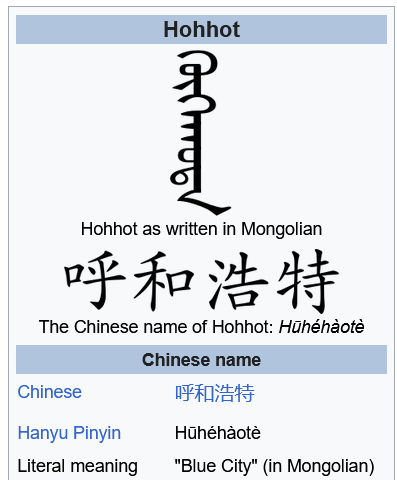
分享到: